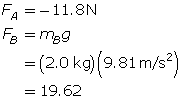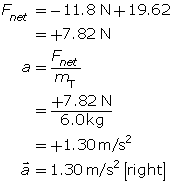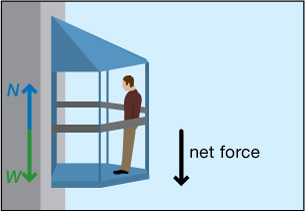Module 3—Effects of Force on Velocity
 Read
Read
Read pages 153 to 157 of your textbook.
 Self-Check
Self-Check
SC 2.
Go to page 158 of your textbook and complete question 9(a) of “3.3 Check and Reflect.”
 Self-Check Answers
Self-Check Answers
SC 2.
Given
mA = 4.0 kg, where mA is the mass of the oak block
mB = 2.0 kg, where mB is the mass hanging down
Required
a = ?
Analysis and Solution
Equivalent system
![]()
![]()
![]() is equal to the friction force on
is equal to the friction force on ![]() .
.
![]() is equal to the gravitational force on
is equal to the gravitational force on ![]() .
.
![]() =
= ![]() +
+ ![]()


Paraphrase
The acceleration of the system is 1.30 m/s2 to the right.
If you have ridden an elevator in a tall building, you have no doubt felt an apparent change in your weight. You feel slightly heavier as the elevator starts upward and a little lighter as it slows to a stop at an upper floor. When you ride back down, you feel lighter when the elevator starts down and slightly heavier as it slows and stops at a lower floor. Can Newton’s laws explain this? Investigate how the motion of an elevator relates to Newton’s laws in the following lab.
 Lesson 5 Lab: Elevator Lab
Lesson 5 Lab: Elevator Lab
Introduction
This lab simulates the motion of an elevator. It helps you apply free-body analysis and Newton's second law to determine the relationship between apparent weight, normal force, and actual weight.
You can learn more about the simulation and how to use it by reading Show Me found at the top of the simulation screen.
Problem
How do you determine the acceleration of an elevator?
Background Information
Before starting the lab, check your understanding for the precise meaning of these terms.
- Weight is the gravitational force exerted by Earth on an object. Note that weight is based on Newton's second law (
 ). Expressed as an equation, it is
). Expressed as an equation, it is

Quantity Symbol SI Unit weight 
N mass m kg acceleration due to gravity 
m/s2 * The acceleration due to gravity at Earth's surface is approximately –9.81 m/s2.
- Normal force is the force exerted by a surface on another body. For example, when you stand on the floor, the floor exerts an upward force on you. The normal force is always perpendicular to the surface.
- Apparent weight is the name given to the force that you exert on another body—perhaps a weigh scale. For example, if you stand on a bathroom scale, you exert a downward force on the scale (your apparent weight). This is equal in magnitude to the normal force that the scale exerts on you. Therefore, the magnitude of the apparent weight equals the magnitude of the normal force.
 Module 3: Lesson 5 Assignment
Module 3: Lesson 5 Assignment
Remember to submit the answer to LAB 4 to your teacher as part of your Module 3: Lesson 5 Assignment.
LAB 4. Using the definitions above, complete the following calculations and explanations.
- Calculate the weight of a 60.0-kg person on Earth's surface.
- Suppose you jumped onto your bathroom scale. Would the scale initially indicate a high weight and then settle down to your actual weight? (Note: The initial weight would be your apparent weight at the moment you landed on the scale.)
- Your apparent weight can be greater than your actual weight. Is this true or false? Explain.
Procedure
Open the Elevator simulation; then continue with the procedure. You may be required to login with a username and a password. Contact your teacher for this information.
- On the simulation, adjust the passenger “Mass” slider (
 ) and observe how the weight and normal force vectors respond. Pay close attention to what happens to the normal force as the weight of the passenger changes.
) and observe how the weight and normal force vectors respond. Pay close attention to what happens to the normal force as the weight of the passenger changes.
- Use the applet to simulate a variety of up-and-down elevator trips at different accelerations for a 60.0-kg passenger. You can change the mass by moving the slider or double-clicking on the slider and entering the number you want. Carefully observe the magnitude of both the normal force and passenger weight throughout each trip.
Observations and Analysis
 Self-Check
Self-Check
SC 3. Answer the following questions based on your observation of the passenger weight and normal force on any elevator trip.
- Is the passenger's weight constant throughout a typical elevator trip regardless of any acceleration?
- Is the normal force constant throughout a typical elevator trip?
- Essentially, an elevator causes motion by adjusting only the normal force. Is this true or false? Explain.
 Self-Check Answers
Self-Check Answers
SC 3.
- Yes, the weight vector is only a product of the passenger’s mass and the acceleration due to gravity.
- No, the normal force changes based on the acceleration of the elevator.
- True. By adjusting the normal force while the weight remains constant, the elevator is able to create a net force acting either up or down, which causes the accelerated motion.
Set up the following parameters on the elevator applet:
- Double-click the mass slider, and enter the mass of the occupant as 60.0 kg.
- Double-click the acceleration slider, and set the acceleration at 4.0 m/s2.
- Press the “Up” button (
 ) to start the elevator.
) to start the elevator.
The elevator will accelerate, coast, and then come to a stop. This represents a typical elevator trip. Observe carefully what happens to the weight (W) and normal force (N) vectors that are drawn on the simulation during each phase of the trip. Once the elevator has stopped, you may wish to reset the elevator and observe the motion again.
 Self-Check
Self-Check
SC 4. Use the terms greater than, equal to, or less than to compare the size of the normal force when the elevator is at rest to the size of the normal force as the elevator
- accelerates upward
- coasts
- slows down
SC 4.
- FN accelerating is greater than FN rest
- FN coasting is equal to FN rest
- FN slowing is less than FN rest
 Module 3: Lesson 5 Assignment
Module 3: Lesson 5 Assignment
Remember to submit the answer to LAB 5 to your teacher as part of your Module 3: Lesson 5 Assignment.
LAB 5. The apparent weight of the passenger equals the magnitude of the normal force acting on the passenger. Use the terms greater than, equal to, or less than to compare the passenger's weight when the elevator is at rest to the apparent weight when the elevator
- accelerates upward
- coasts
- slows down
 Self-Check
Self-Check
SC 5. Based on your observations and experience riding in an elevator, which force, weight or apparent weight, do you feel when the elevator
- accelerates upward
- coasts
- slows down
SC 6. Complete the table by drawing the free-body diagrams in each phase of the elevator trip. Indicate the relative magnitude (size) of the normal force and the weight on each diagram.
(speeding up)

(constant speed)

(slowing down)

SC 7. The net force acting on the occupant is the sum of all force acting on the occupant. This is described by
![]()
a. Rewrite the equation using Newton's second law, where
- “
 ” is substituted for “
” is substituted for “ ”
” - “
 ” is substituted for “
” is substituted for “ ”
”
(______) = (![]() ) + (______) (2)
) + (______) (2)
b. Manipulate the equation in SC 7.a. in terms of the normal force (![]() ).
).
![]() = (______) – (______) (3)
= (______) – (______) (3)
SC 5.
a. apparent weight
b. weight
c. apparent weight
SC 6.
a. 
b. 
c. 
SC 7.
a. (![]() ) = (
) = (![]() ) + (
) + (![]() )
)
b. ![]() = (
= (![]() ) – (
) – (![]() )
)
The equation ![]() = (
= (![]() ) – (
) – (![]() ) can be used to determine the apparent weight of a passenger when the acceleration (
) can be used to determine the apparent weight of a passenger when the acceleration (![]() ) of the elevator is known.
) of the elevator is known.
For example, what is the apparent weight of a 55.0-kg person on an elevator that is accelerating upward at 3.00 m/s2?

 Self-Check
Self-Check
SC 8. An elevator ride consists of three distinct phases characterized by the acceleration of the elevator itself: accelerating upward, coasting/resting, and accelerating downward. Complete the following chart. Calculate the normal force using equation ![]() = (
= (![]() ) – (
) – (![]() ) and the values for m = 60.0 kg and
) and the values for m = 60.0 kg and ![]() = +4.0 m/s2 for each phase of the elevator trip. The value of
= +4.0 m/s2 for each phase of the elevator trip. The value of ![]() is –9.81 m/s2. You will need to set the mass of the passenger and the acceleration (
is –9.81 m/s2. You will need to set the mass of the passenger and the acceleration (![]() ) of the elevator in the applet. Note that the direction and magnitude of the acceleration will be different in each phase of the trip and that they are indicated in the following table. Verify your answers on the simulation using the normal force value from the scale reading shown in the upper left corner of the applet.
) of the elevator in the applet. Note that the direction and magnitude of the acceleration will be different in each phase of the trip and that they are indicated in the following table. Verify your answers on the simulation using the normal force value from the scale reading shown in the upper left corner of the applet.
Accelerating Upward (+) |
|
| Coasting/Resting (constant speed) |
|
| Accelerating Downward (–) (slowing down) |
SC 9. Consider the three distinct phases of an elevator ride:
- accelerating upward (speeding up)
- coasting/resting (constant speed)
- accelerating downward (slowing down)
For two of the phases of the ride, scale readings indicate apparent weight. For the remaining phase, the reading is actual weight.
- In which two phases are the scale readings apparent weights?
- For which phase does the scale reading represent the "heavy" sensation you would feel on this elevator trip?
- For which phase does the scale reading represent the "light" sensation you would feel on this elevator trip?
SC 8.
Accelerating Upward (+) |
|
| Coasting/Resting (constant speed) |
 |
Accelerating Downward (–) (slowing down) |
 |
SC 9.
- accelerating upward and accelerating downward
- accelerating upward
- accelerating downward
 Read
Read
To reinforce what you have learned in the elevator lab so far and to prepare for your next assignment question, read “Applying Newton’s Second Law to Vertical Motion” on pages 151 to 153 of your textbook.
 Module 3: Lesson 5 Assignment
Module 3: Lesson 5 Assignment
Remember to submit the answer to LAB 6 to your teacher as part of your Module 3: Lesson 5 Assignment.
LAB 6. Use the simulation for assistance in answering the following questions.
- Calculate the apparent weight of an 80.0-kg person riding in an elevator that is accelerating upward at a rate of 5.00 m/s2.
- Use a free-body diagram to explain what happens to the apparent weight of a person if the elevator begins to "free fall" (accelerating downward at 9.81 m/s2).
- You are in an elevator that is accelerating upward at 6.00 m/s2. If your apparent weight is 800 N, what is your mass?
- A passenger on an elevator experiences an apparent weight of 500 N while accelerating downward. If the mass of the passenger is 70.0 kg, at what rate is the passenger accelerating?
- While travelling down between floors at a constant speed, a passenger has a weight of 800 N. During the acceleration to stop the elevator, the passenger experiences an apparent weight of 1000 N. Calculate the acceleration of the elevator.
Conclusion

The acceleration of an elevator can be determined using free-body analysis and Newton's second law.
![]()
The observed acceleration (a) is related to the net force by Newton's second law.
![]()
N is the normal force, which is equal in magnitude to the passenger’s apparent weight.
W is the actual weight of the passenger, produced by the effect of the gravity acting on a mass: W = mg
